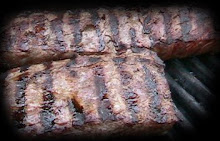Dry Roasting of Venison can be done with the following cuts: Hind Leg (Rounds, Eye of Round, Peeled Knuckle, and Sirloin), 8 Rib Rack, Strip Loin, Shortloin, and the Tenderloin. These are the more tender cuts. Less tender cuts such as the Chuck Roast and 4 Rib Shoulder Roast must be cooked with moisture. Roasting is to cook by exposing to direct heat, without moisture, by sealing with browning. To brown and carmaelize venison that are roasted, it is necessary to baste them, don’t overdo it (approximately 1 tablespoon per pound of roast), with (2/3 rds Olive oil and 1/3 butter is best. Roasting is done in the oven or on a spit.
In the oven one should always preheat before anything is cooked in it. The temperature depends on the size of the piece of Venison however 475 -550 degrees is a good start to brown the surface of the roast and seal in all its juices.
Rub the Venison with the Olive Oil and Butter, place in a Roasting Pan. The pan can either be put in the very hot oven or can be browned on the top of the stove. Turn (never prick the surface with a fork, turn with tongs) and brown all sides, (for myself, it is easier to brown and carmalize on the top of the stove so that I can watch without burning and to make sure that all sides become evenly brown, then take off the stove and place in an oven of 400 degrees or if browned in the very hot oven - turn down the oven to 400 degrees to complete the cooking. I always use a meat thermometer (Pyrex Accessories) because it is so easy to over cook, as it cooks much quicker than beef or pork.
I wait till the meat thermometer reads 135 degrees, then remove the Roast from the oven or spit and let rest for 15 -20 minutes. For very large roasts such as whole hind legs the resting time should be about an hour. After roasting, while resting, cover with a roasting pan lid or aluminum foil to keep the roast warm and it will keep cooking without cooking out any of the moisture. The muscle tissue will relax making the meat more tender and the juices move from the middle of the roast to even out the moisture content.
If the cut of Venison is too sensitive to heat and begins to burn, cover with aluminum foil. This includes the ends of the bones on the 8 Rib Rack).
Sauses, gravies, au jus for the roast are best made from the juice of the meat, Olive oil, and butter that has collected in the roasting pan. To do this deglazes the pan by adding twice as much hot water as the total amount of sauce that you want to end up with. With a spoon, loosen all the carmaelized juices stidking to the bottom of the pan so they will dissolve in the liquid. Boil and reduce the sauce by half (about 2 tablespoons of reduced liquid per serving). Keep warm….to make the sauce a bit smoother and sweeter add pieces of softened butter and swirl into it, also a few drops of good red-wine vinegar may be added to enliven and bring more character to the sauce.
Chuck Roast or 4 Rib Shoulder Roast should be braised. Braising is to cook in low moist heat with fat and water or fat and other liquid. These cuts can be marinated first or not. Then floured, or not, and browned lightly in Olive Oil and then add vegitables and liquid (wine, bouillon, or stock) to cover at least half the piece of venison. The pot should be covered with a lid when braising. The cooking must be gentle, long and even, usually 225 -300 degrees for 2 -3 hrs. As the meat tenderlizes the roast exudes juices into the liquid that heightens the flavor, which gradually transformes the sauce into a rich flavorful sauce or gravy. This meat should be very tender, enough to fall off the bone or shred, when done.
Visit www.venisonsteaks.com for Venison roast, deer steaks, venison burgers and more.
Wednesday, July 15, 2009
Subscribe to:
Post Comments (Atom)







No comments:
Post a Comment